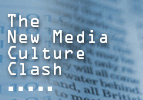



Cheryl Ball’s qualification that new media must employ multiple semiotic modes in “aesthetically pleasing ways” injects an element of subjectivity that hinders the clarity she seeks. In some instances, the author of a new media argument may design elements that are aesthetically displeasing to achieve a particular rhetorical effect while meeting all of Ball’s other criteria for “new media.” Similarly, failure to achieve a desired aesthetic shouldn’t automatically preclude an argument from being “new media.” It might simply be a bad new media argument. A paper turned in for a college class, may employ a stilted style or fail to use accepted genre conventions, but we would not deny it was an essay or even some form of writing. It was merely an unsuccessful attempt. For these reasons, I offer the term “digital media” as a more appropriate substitute for “new media.” A digital argument is constructed using digital tools and usually employs multiple modalities and/or a non-linear structure. It is generally delivered online.
Ball’s definition (indeed, her argument as a whole) privileges that which breaks most dramatically from current text-based conventions. While I agree that the experimental should be prized and that it is incumbent upon new media scholars to push the boundaries of traditional scholarship, widespread acceptance of non-print-based argument will rely on both faculty and students increasing their comfort level with digital media. That is unlikely to happen if we expect those unfamiliar with or uneasy about digital media to jump immediately to the far end of the spectrum and engage in experimental multimodal argument.
Just as the advent of writing technologies like pencil, paper, and the printing press drove a transition from orality to literacy, new digital tools transform our existing concepts of literacy and challenge writing as the primary (or, at least, exclusive) mode of scholarly argumentation within our academic culture. As a body of study and instruction, rhetoric has survived such a transition before adapting to the written form despite its oral roots. It will do the same now — albeit, of necessity, at a faster pace. Mary Hocks calls on Richard Lanham’s theories in offering digital rhetoric as a body that embraces multiple modalities. She argues:
Any rhetorical theory works as a dynamic system of strategies employed for creating, reacting to, and receiving meaning…. Thus, digital rhetoric describes a system of ongoing dialogue and negotiations among writers, audiences, and institutional contexts, but it focuses on the multiple modalities available for making meaning using new communication and information technologies (2003, 632).This digital rhetoric serves as a series of strategies that utilizes new media tools and embraces multimodal approaches to establish meaning and persuade. Digital rhetoric encompasses the interactive features of the web and new media technologies. It considers and capitalizes on a wide range of sensory modalities including, for example, visual and audio elements. It recognizes the deep and profound impact new technologies have on our communications and efforts to persuade.
When the “new” gets old • In the eye of the beholder • Moving across the continuum • Works cited • Home